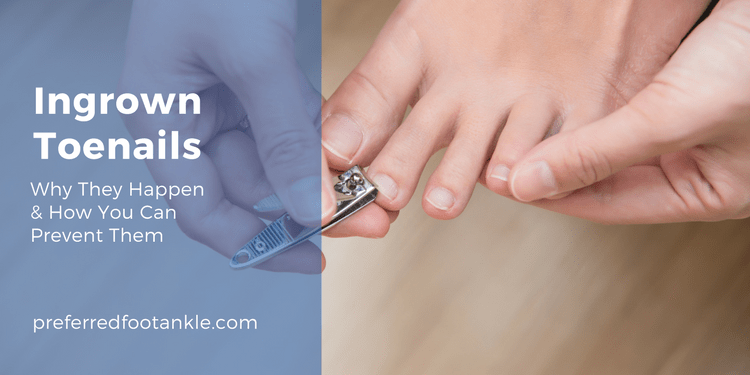“Man, Dave from Shipping and Receiving is a real thorn in my side!”
Okay, we realize there might not actually be a “Dave from Shipping and Receiving” at your place of employment—and if there is, it’s entirely plausible Dave is a helpful, well-liked guy who never annoys you—but the odds are fairly high you’re at least familiar with the colloquialism.
Humans have been using the phrase “thorn in my side [or flesh]” for a very long time, and for good reason – it perfectly captures the feeling of a persistent annoyance.
Sometimes, however, the feeling isn’t just a clever metaphor.
Now, you may not have a literal thorn pressing into your flesh, but this kind of physical sensation can come from an ingrown toenail.
An ingrown toenail condition is one marked by a side or corner of the affected toenail growing into the soft flesh surrounding it. This can lead to symptoms like pain, swelling, redness, and even an increased risk of infection.
Please be aware that in the event you happen to notice pus or spreading redness (signs of a potential infection), or you are having severe pain in the area, it is important to contact Preferred Foot & Ankle Specialists and request an appointment for the professional treatment you need!
Whereas this condition can technically happen to any of the toes, it is most frequently experienced in the big toe or, to a lesser extent, the little toe.

Causes of Ingrown Toenails
There are several common causes for nails that become ingrown, including:
- Inherited structure – Nails that are unusually curved are simply more likely to become ingrown than those that feature a more typical shape.
- Physical trauma – Dropping something heavy onto your foot increases your risk of developing this condition. Another source of physical trauma is accidentally kicking a hard surface of some kind or other, which helps explain why the toes on the edges of the foot have a greater risk factor than do the middle ones.
- Improper nail trimming – Patients who trim their nails too short or round them off have a greater rate of ingrown toenail occurrence than do those who clip them straight and keep the nails even with the edge of their toes.
- Ill-fitting footwear – Shoes that fit poorly create or contribute to a host of issues, including ingrown toenails. Footwear that is too tight crowds the toes together, which makes it more likely that ingrowing will take place.
How to Treat Ingrown Toenails
The best place to start with treating ingrown toenails is with home care. Using the following steps may provide the relief you seek:
- Soak your feet for 15-20 minutes in warm water to soften the nail tissue. This will relieve tenderness and can reduce swelling.
- After soaking, place a fresh bit of waxed dental floss under the edge that has become ingrown. Some sources may recommend using cotton, but this can potentially contribute to an increased risk of infection.
- Use antibiotic cream or ointment on the tender area and then properly bandage the affected toe.
When home treatment is insufficient, professional treatment options we provide may include lifting the nail, partial nail removal and, for recurrent cases, even removing the affected nail tissue altogether.
You might think removing a toenail would be painful—and especially if you consider how much it hurts when something gets deep between a nail and its respective nailbed—but this is not something to worry about. Anesthesia is used to numb the area prior to the procedure.
Once we have removed the nail, we will likely perform a special procedure to keep the toenail from growing back. The reason for this is simply to prevent the problem from repeatedly occurring.
We don’t want you to have the same discomfort and pain over and over again, so we can take measures to keep the nail matrix unable to generate new nail tissue. You should be aware that this procedure is permanent (so no surprises later on).
After your surgery, your nail will be covered with antibacterial ointment and gauze. It is very important to follow all of our post-operative instructions, especially ones for keeping the wound clean.
Any operation presents its own unique set of potential risks. It’s important to understand what to expect both during the procedure and during the healing period.

A toenail removal is done on an outpatient basis, meaning you may leave the same day. You should be prepared to have someone drive you to and from the appointment (on account of anesthesia use). You will probably be able to put pressure on your feet, but it may be uncomfortable for a bit.
How to Prevent Ingrown Toenails
Prevention is much better than having to treat a condition, especially when the steps are relatively easy and straightforward. For ingrown nails, this entails:
- Proper nail trimming – Always clip your nails straight across, instead of rounding them off, and keep them even with the edge of the toes.
- Footwear that fits – When buying shoes for yourself or loved ones, make sure they are not tight in the front and have enough room that toes can wiggle freely.
- Protect your feet – If your job requires frequently moving heavy items, invest in a quality pair of safety shoes or steel-tipped work boots.
If you require professional care for a problem case of ingrown toenails, give Preferred Foot & Ankle Specialists a call at (480) 497-3946. You can also contact our office online right now!





